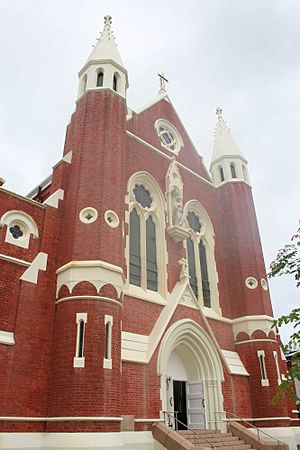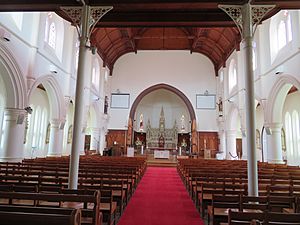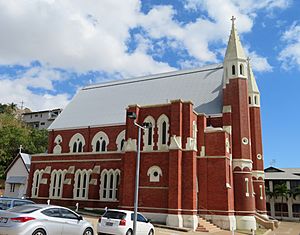Sacred Heart Cathedral, Townsville facts for kids
Quick facts for kids Sacred Heart Cathedral, Townsville |
|
|---|---|
| Church of the Sacred Heart | |

Sacred Heart Cathedral, 2007
|
|
| 19°15′32″S 146°48′42″E / 19.2589°S 146.8118°E | |
| Country | Australia |
| Denomination | Roman Catholic |
| History | |
| Status |
|
| Founded | 7 October 1900 |
| Founder(s) | Right Rev. Dr Joseph Higgins, Bishop of Rockhampton |
| Dedication | Sacred Heart of Jesus |
| Dedicated | 16 November 1902 by Bishop Joseph Higgins |
| Architecture | |
| Architect(s) | Reed, Smart & Tappin |
| Architectural type | Church |
| Style | Gothic Revival |
| Years built | 1896–1902 |
| Specifications | |
| Materials | Brick; corrugated iron |
| Administration | |
| Diocese | Townsville |
The Sacred Heart Cathedral is a beautiful and historic Roman Catholic church located in Townsville, Queensland, Australia. It is a special building because it is "heritage-listed," meaning it is protected for its historical importance. The church was built between 1896 and 1902. It is also known as the Church of the Sacred Heart.
This cathedral is the main church for the Roman Catholic Diocese of Townsville. It is where the Bishop of Townsville has his official seat. The current bishop is Tim Harris.
Contents
Building History
Early Days of the Church
The first Catholic church in Townsville was St Joseph's, built in the 1870s. Townsville itself started in the mid-1860s as a port for nearby farming areas. When gold was found in places like Ravenswood and Charters Towers in the 1870s, Townsville grew very quickly. By the 1890s, it was the most important port in North Queensland.
As more people moved to Townsville, the Catholic community needed a bigger and more central church. In 1884, Father William Mason Walsh, the local priest, bought land on Stanley Street. This land was on the slopes of Castle Hill, overlooking the main part of Townsville. He hoped to build a grand new church there. However, at that time, Townsville was part of the Roman Catholic Diocese of Rockhampton, and the local church was not very big or wealthy. So, building plans for the new church on Stanley Street did not start until the 1890s.
Designing the Cathedral
In 1894, a competition was held to design the new church. The winning design came from famous architects Reed, Smart & Tappin from Melbourne. Their plan was for a large brick building in the Gothic style. It would have a big basement, a main church area with a nave (the central part), aisles (side sections), a transept (cross-shaped part), and a sanctuary (area around the altar). The design also included a tall front tower and spire, planned to be about 162 feet (49 meters) high. Some people believe this design was a smaller version of the Sacred Heart Cathedral in Bendigo, Victoria, which the same architects also designed.
Construction and Challenges
Work on the Stanley Street site began in 1896. The foundations and basement were built first, costing £1,160 just for the basement. After this, there was a pause in construction.
On October 7, 1900, the foundation stone was laid by Bishop Joseph Higgins from Rockhampton. However, the main part of the church (the nave and aisles) did not start until early 1902. Denis Kelleher, who had built the Catholic cathedral in Rockhampton, won the contract. He finished the first stage of the building in just 10 months, costing £8,330. Bishop Higgins blessed and opened the church on November 16, 1902. The inside of the church was beautifully finished with fine ceilings made of varnished pine.
Just over three months after it opened, the Church of the Sacred Heart was badly damaged by Cyclone Leonta. This cyclone hit Townsville on March 3, 1903. The church's roof was torn off, and the inside suffered a lot of water damage. The damage was repaired, but the original plan to build a belltower and extend the church was never fully completed. A steel bell tower was added later.
Becoming a Cathedral
Around 1931, the Roman Catholic Diocese of Townsville was created. Because the Church of the Sacred Heart was the main church for the Bishop of Townsville, it officially became a cathedral.
The roof was damaged again in 1972 during cyclone Althea, causing more water damage to an inside wall. The steel belltower was removed in the 1970s and given to a chapel at Lavarack Barracks. Part of the decorative iron and brick fence around the church was also removed at that time.
Cathedral Design
The Sacred Heart Cathedral has a rectangular shape and is designed like an old Roman basilica. It has a high ceiling above the main area (the nave) and side sections called aisles. The area around the altar is called an apse, framed by a timber arch. The ceiling is made of wood panels. The roof is made of corrugated iron.
The front of the church has two small towers (turrets) and large Gothic-style windows. There is also a central statue niche. The outside walls are made of red bricks with special mortar joints and contrasting cement decorations.
An interesting fact about the cathedral is that it faces north-south, which is different from most cathedrals that face east-west. This was likely because of the limited space on the hillside where it was built. The entrance is from Stanley Street, and the altar faces southwest.
The cathedral is built on a rocky part of Castle Hill. It stands across from another important church, St James Anglican Cathedral, and both overlook the city center. The lower parts of the hill around the cathedral have grass and small bushes. A stone wall holds back the earth around the church, creating a road from Stanley Street. There are grassy areas and small shrubs around the building and at the base of the main stairs.
Near the cathedral is a two-story brick building called a presbytery, built in 1938. This building houses the bishop and the priest of the cathedral parish. Its red brick and stucco design matches some of the decorative features of the cathedral.
Why is it Heritage Listed?
Sacred Heart Cathedral was added to the Queensland Heritage Register on October 21, 1992. This means it is recognized as an important historical site for several reasons:
- Showing Queensland's History: The cathedral, built between 1896 and 1902, shows how the Catholic Church worked to establish itself in the growing towns of 19th-century Queensland. The fact that the original grand design was never fully built shows the challenges the Catholic Church faced in North Queensland. These challenges included economic problems in the 1890s, a drought from 1900-1902, and the damage from Cyclone Leonta in 1903.
- A Great Example of Church Design: The Sacred Heart Cathedral was designed to be impressive. It is a great example of a large brick church that uses traditional Gothic design elements, even though it is located in a tropical climate.
- Beautiful and Important to the City: The cathedral is in a very noticeable spot on Castle Hill, overlooking Townsville. It has strong aesthetic value, meaning it is very beautiful and adds a lot to the look of the city.
- Important to the Community: As a landmark, the cathedral is very important to the local community. It continues to be a central place for Catholicism in North Queensland. It has been a significant place for Catholic worship in Townsville since 1902.
See also
 In Spanish: Catedral del Sagrado Corazón (Townsville) para niños
In Spanish: Catedral del Sagrado Corazón (Townsville) para niños




